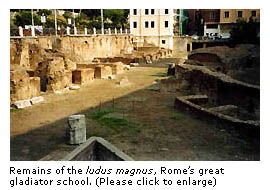Ludi
The Latin word ludus means on one hand the games such
as chariot races and theatrical displays, but not the gladiator
shows, which were called munera. On the other hand,
the term ludus referred to the gladiator school which
was run by a lanista (owner of the ludus). He
also owned the gladiators which he rented to the editor.
However, the Imperial ludi were under the control
of certain officials which were called procuratores.
There was one procurator for each of the four Imperial
ludi in Rome. The most famous one was the ludus
magnus, built next to the Amphitheatrum Flavium (known
today as the Colosseum). It was connected to the Colosseum
by an underground pathway, so that the gladiators could get
to the arena unseen. 
Not only the gladiators were part of a familia gladiatoria,
but also many servants such as the doctores also called magistri
(coaches), who were in most cases former gladiators and taught
in the discipline in which they had fought themselves, as
well as medici (physicians). For example, Claudios
Galenos, the later personal physician of Marcus Aurelius,
worked as a physician at the gladiator school in Pergamon.
Furthermore, there were servants responsible for the clothes
(a veste gladiatoria), for the decoration of the games
(adiutores procuratoris rationis ornamentum) and for
the weapons and equipment, e.g., the manicarius for
the manica (arm protection).
The training sessions followed extremely rigid rules. We
can assume that all new recruits had to undergo the same basic
training to learn about their mannerisms and to assign them
to the type that suits them. At first the fighters trained
at the palus (practice pole) before the training with
wooden weapons started. In his Epitoma Rei Militaris,
the late Antique historian Vegetius compares the training
of gladiators with that of soldiers.
|
